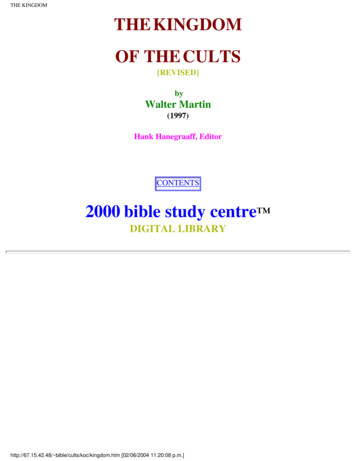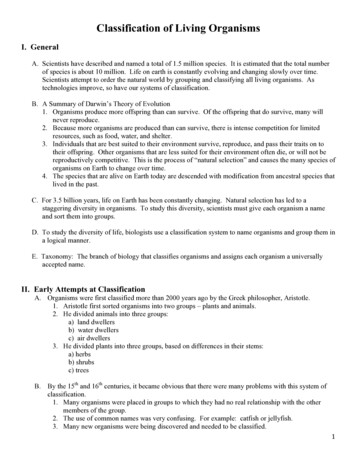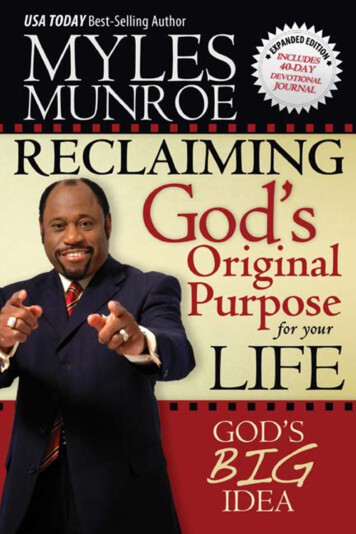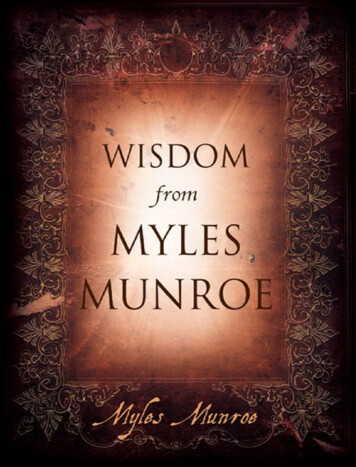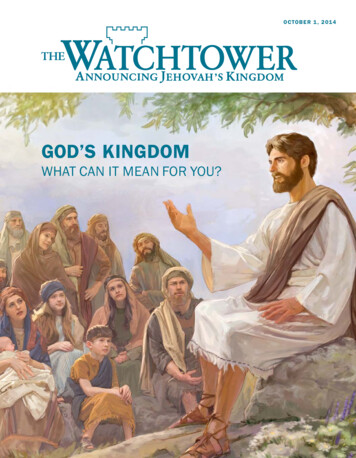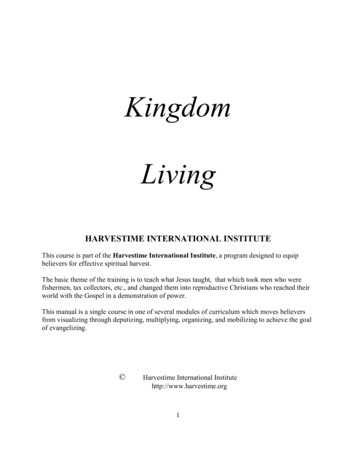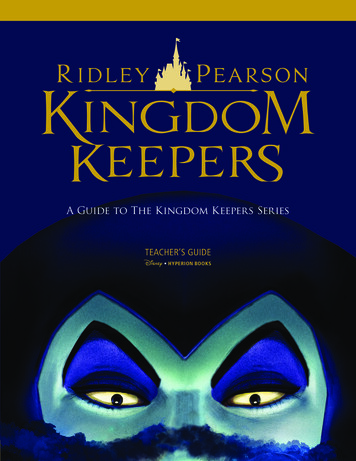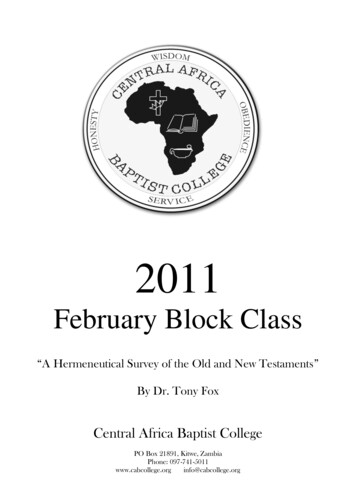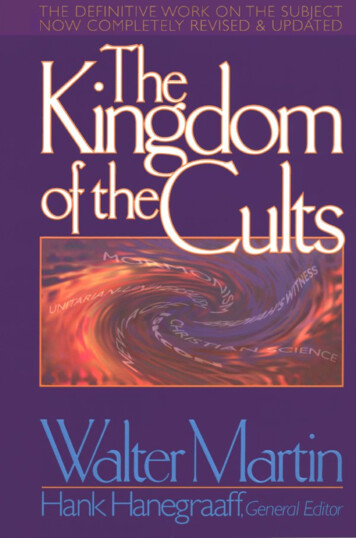
Transcription
THE KINGDOM OF THE CULTS(REVISED)byWALTER MARTINHANK HANEGRAAFF, GENERAL EDITORBETHANY HOUSE PUBLISHERSMinneapolis, Minnesota, 55438A Division of Bethany Fellowship, Inc.
COPYRIGHTS AND PERMISSIONSCopyrightsThe Kingdom of the Cults (Revised)Copyright 1965, 1977, 1985, 1997 The Estate of Walter Martin.Electronic Edition STEP Files Copyright 1997, Parsons Technology, Inc., PO Box 100,Hiawatha, Iowa. All rights reserved.License StatementThis book is licensed for the exclusive use of the original purchaser (“you”) for use on onecomputer only. This book is not copy protected. Parsons Technology authorizes you to make backupcopies of the software for your archives only, for the sole purpose of protecting your investment fromloss. You are free to move this book from one computer location to another, as long as there is nopossibility of it being used at two locations at one time. This electronic book should be treated like aprinted book, which cannot be read by two people at two different locations at the same time.Permission to QuoteAll rights reserved. No part of this publication may be reproduced, stored in a retrieval system, ortransmitted in any form or by any means electronic, mechanical, photocopying, recording, or otherwisewithout the prior written permission of the publisher and copyright owners.Using Copyrighted InformationThe text in STEP-compatible books is copyrighted by various publishers, but certain uses areallowed as outlined below. Federal copyright laws allow for “fair use” of copyrighted materials withoutpermission under certain circumstances. The law allows the reproduction, distributions, and adaptationof copyrighted material if the use is “for purposes such as criticism, comment, news reporting, teaching(including multiple copies for classroom use), scholarship, or research.”To judge if your use falls under these guidelines, you should take into consideration ALL of thefollowing:1. Is the use commercial or non-profit educational? In general, commercial use is not coveredunder “fair use.”2. Is the material relevant to the context in which it is used? That is, you can’t justify copyingmaterial about the Flight from Egypt or the Civil War by handing it out to a classroom of mathstudents.3. How much of the material are you reproducing? In general, reproducing a small amount of textis allowed under “fair use,” but reproducing all (or most) of a publication may not be.4. What is the effect on the potential value of the copyrighted source material? If your use mayreduce our sales or those of other copyright holders, it’s likely your use is not “fair.”One general rule to consider is to put yourself in the place of the copyright holder. How would youreact if someone used your material in the way that you’re contemplating? If you think your usage may
not qualify as “fair use,” contact the institution holding the copyright.(By the way, some of the material above is adapted from Every Writer’s Guide to Copyright &Publishing Law by Ellen M. Kozak, copyright 1990, Ellen M. Kozak.)Note: Please do not contact Parsons Technology concerning the right to quote material from STEPcompatible books. Since most of the original, source material in your STEP-compatible books iscopyrighted by someone other than Parsons Technology, we are unable to offer assistance. You shouldbe able to identify the copyright holder from the information included above.
OTHER BOOKS BY WALTER MARTINChristian ScienceEssential ChristianityHerbert W. Armstrong and the Worldwide Church of GodJehovah of the WatchtowerJehovah’s WitnessesThe Maze of MormonismMormonismNew Age CultsThe New CultsThe Riddle of ReincarnationScrewtape Writes AgainWalter Martin Speaks Out on the CultsWalter Martin’s Cults Reference Bible
ABOUT THE AUTHORWALTER MARTIN was fondly and respectfully known as “the father of Christian cultapologetics.” Many current professional and academic cult apologists credit him with their introductionto the field. He held four earned degrees, having received his Doctorate from California CoastUniversity in the field of Comparative Religions. Author of a dozen books, a half-dozen booklets, andmany articles, he was known nationwide as “The Bible Answer Man,” host of one of the oldest andmost popular nationally syndicated call-in radio programs. He was founder and director of the ChristianResearch Institute, located in Southern California, which continues to provide cult apologeticsinformation and to sponsor the ever-popular Bible Answer Man daily broadcast.
ABOUT THE GENERAL EDITORHANK HANEGRAAFF, author of Counterfeit Revival, is president and chairman of the board ofChristian Research Institute International, the oldest and largest organization in the world specializingin the study of cults and fringe religious movements, contemporary religious controversies, and relatedissues. Hanegraaff is heard live daily as host of the nationally syndicated Bible Answer Man radioprogram.His bestselling book Christianity in Crisis, was awarded the Gold Medallion by the EvangelicalChristian Publishers Association. His other books include Personal Witness Training: Your Handle onthe Great Commission and Memory Dynamics: Your Untapped Resource for Spiritual Growth. Hecontributes regularly to Christian Research Journal. Hanegraaff lives in Southern California, with hiswife, Kathy, and their eight children.
ABOUT THE MANAGING EDITORGRETCHEN PASSANTINO, co-director of Answers in Action, is an award-winning author andinvestigative journalist who has spent more than two decades in cult apologetics team ministry with herhusband, Bob. She helped the late Dr. Walter Martin establish Christian Research Institute in Californiain 1974, and was his senior research consultant during the ministry’s formative California years. Sheworked with Dr. Martin on various book projects, including The New Cults and previous editions ofThe Kingdom of the Cults. She is best-known for Answers to the Cultist at Your Door, When the DevilDares Your Kids, and Satanism, as well as for her investigative work regarding contemporary Satanism.
ABOUT THE RESEARCH CONTRIBUTORSEach of the contributors to this updated and expanded edition have years of experienceunderstanding, explaining, and defending the Christian faith, and each is thoroughly competent in theareas for which they provided revising, updating, editing, and/or content for this edition. RichardAbanes, Alan Gomes, Bill McKeever, Richard Mendoza, Bob Passantino, Gretchen Passantino, CecilPrice, and Kurt Van Gorden have remained faithful to the vision of Walter Martin while bringing TheKingdom of the Cults to the cutting edge of cult apologetics and scholarship today. Most of thecontributors regard the late Dr. Martin as their mentor, and all look to his example as an able defenderof the faith “once for all delivered to the saints” (Jude 3).
PUBLISHER’S INTRODUCTIONWhile contemporary treatments of multiculturalism evoke images of a tossed salad rather than amelting pot, the proliferation of new religious movements with at least a veneer of Christianity wasnever greater. From the iconoclastic Branch Davidians of Waco, Texas, to the quiet secrecy of theSoldiers of the Cross, religious pluralism in competition with historic Christianity is at an all-time high.This thirtieth-anniversary edition of The Kingdom of the Cults proves the almost prophetic vision of thelate Dr. Walter Martin, who warned that the cults were “the great mission field on the Church’sdoorstep.” Today, more than ever, we need the insight of a mature Christian, master apologist, andcomprehensive theologian to guide us into cult evangelism at the end of the century.Dr. Walter Martin died in 1989, after a ministry of almost forty years in cult apologetics. Holdingfour earned degrees, Dr. Martin was recognized as the leading authority in America on American cults.He was the author of a dozen books, many booklets, and uncounted articles. His Kingdom of the Cultsis the standard reference work on American cults. He was founder and host of the internationallysyndicated, live call-in radio talk program The Bible Answer Man, and founder, director, and presidentof the internationally recognized and acclaimed Christian Research Institute, which continues his vitalwork today. Dr. Martin taught at various seminaries and Bible colleges through the years and mentoredmany who have since become leaders in the counter-cult ministry field. He was deservedly called “theFather of cult apologetics.”This edition of The Kingdom of the Cults is both old and new. It epitomizes the best in classic cultapologetics pioneered and refined by Dr. Walter Martin. At the same time, it includes the bestcontemporary information about the onslaught of the cults in America and around the world today.Every effort has been made to maintain the integrity of the original volume. The eternal verities ofScripture are as central to this edition as in Walter Martin’s previous editions. The enduring heresies ofthe traditional cults are reinforced in this edition with contemporary references and documentation.Current statistics, practices, and beliefs are carefully explained and refuted from God’s Word. Newcults not addressed in previous editions are fully examined and countered in this new edition. Thisvolume reflects the godly spirit and scholastic brilliance of the late Dr. Walter Martin. His clarion callof thirty years ago should ring even louder today as the Christian church faces the new century withevangelistic urgency.
GENERAL EDITOR’S INTRODUCTIONThe revised, updated, and expanded thirtieth anniversary edition of The Kingdom of the Cults couldnot have been released at a more strategic time in church history. More than three decades ago, WalterMartin warned that cultism would have a devastating impact on the culture. Today cultism is having anequally devastating impact on the church. The line of demarcation between the kingdom of the cultsand the kingdom of Christ is not only being blurred, it is being obliterated.Recently, a book entitled How Wide the Divide? was released by a major evangelical publisher.This book, coauthored by a professor of a major evangelical seminary, wistfully looks forward to theday “when youth groups or adult Sunday school classes from Mormon and evangelical churches in thesame neighborhoods would gather periodically to share their beliefs with each other in love and for thesake of understanding not proselytizing.”Int-1 According to the authors, Mormons and evangelicals agreethat “the Father, the Son, and the Holy Spirit are one eternal God.”Int-2 The truth of course is that theydo not! As James White, author of Is the Mormon My Brother?, aptly points out, “The only way tomake such a statement is to so redefine every word used as to make the entire effort meaningless.”Int-3In The Kingdom of the Cults Walter Martin prophetically warned that the day would come whenChristians would be unable and unwilling to “scale the language barrier.” Today as never before cultistsof all stripes are using Christian terminology while pouring their own meanings into the words, in theprocess sometimes fooling even conservative evangelical leaders. While the authors of How Wide theDivide? suggest that we worship the same God, in reality the God of historical biblical Christianity isvastly different from the God of Mormonism. According to Mormonism, “As man is, God once was; asGod is, man may become.”Int-4 Mormon founder Joseph Smith goes so far as to say God was “once aman as we are now.”Int-5 In stark contrast to the God of Mormonism, the God of Christianity is infiniteand immutable. The distance between them is the distance of infinity.In minimizing the “divide” between the kingdom of Christ and the kingdom of the cults one canhope to forge only superficial friendships with cultists. If we genuinely want to influence a cultist forChrist, it is necessary, as Walter Martin did, to tell the truth about the vast chasm that separates us.Walter Martin’s witness and writings have been used by the Lord to move multitudes out of cultisminto Christianity.While Walter Martin has gone on to be with his Lord, it is my prayer that The Kingdom of the Cults,his magnum opus, will equip yet another generation of cult apologists. As you read on, you will beprepared to reach out to the mission field on your own doorstep as well as mission fields in distantlands. More than that you will be inspired to be a tool in the hands of almighty God in the process ofchanging lives for time and for eternity.Not only can the lives of individuals be transformed but entire unbiblical movements can betransformed as well. Consider the Worldwide Church of God. In previous editons of The Kingdom ofthe Cults, this movement was listed as a non-Christian cult. This edition, however, notes their journeysince then from cultism to the Cross. Joseph Tkach Jr., pastor-general of the Worldwide Church of God,best summarized this transformation when he wrote, “Gone are our obsessions with a legalisticinterpretation of the Old Testament, our belief in British Israelism, and our insistence on ourfellowship’s exclusive relationship with God. Gone are our condemnations of medical science, the useof cosmetics, and traditional Christian celebrations such as Easter and Christmas. Gone is our long-heldview of God as a ‘family’ of multiple ‘spirit beings’ into which humans may be born, replaced by abiblically accurate view of one God who exists eternally in three Persons: the Father, the Son, and theHoly Spirit. We have embraced and now champion the New Testament’s central theme: the life, death,and resurrection of Jesus Christ. Jesus’ saving work on behalf of humanity is now the focus of ourflagship magazine, The Plain Truth, rather than end-time prophectic speculation. We proclaim thesufficiency of our Lord’s substitutionary sacrifice to save us from the penalty for sin. We teach
salvation by grace, based on faith alone, without resort to works of any kind.”Int-6This thirtieth anniversary edition of The Kingdom of the Cults not only maintains the integrity of Dr.Martin’s profoundly original work but adds current, up-to-date information and in-depth analysis inuser friendly fashion. As General Editor, I have preserved Walter Martin’s original thoughts whileupdating and extending them through those who have effectively mastered the spirit of his work.Several completely new chapters, reflecting significant changes in the field of cult apologetics havealso been added. These changes are noted in footnotes at the head of chapters.I would like to express my appreciation to Gretchen Passantino who, as Managing Editor, did thelion’s share of the work on this project. I am also deeply grateful for the contributions of the team ofcontributors she assembled. With the diversity of theological perspectives represented, disagreementson secondary issues are inevitable. Walter Martin and I, for that matter, hold differing views on avariety of issues, such as eschatology. We are all, however, firmly united around the maxim, “Inessentials unity, in nonessentials liberty, in all things charity.”Thus with the deepest of gratitude to our Lord Jesus Christ for raising up the ministry of Dr. WalterMartin, we submit to His purposes this new edition of The Kingdom of the Cults.
ACKNOWLEDGMENTS TO THE 1985 EDITIONI wish to express my deep gratitude to Pierson Curtis, former senior master of the StonybrookSchool, who helped edit and correct the original manuscript; the Rev. Anthony Collarile, Messrs.Herbert Jacobsen, Robert Smith, and John Carter, who offered valuable insights and research data; Mr.Walter Bjorck Jr., of the American Tract Society, who made many helpful manuscript suggestionswhich were adopted in a number of instances; editor-researcher Gretchen Passantino, who revised themajority of this present edition; researcher Kurt Van Gorden for his invaluable assistance especially onthe newer cults; and associate Clark F. Hyman, who also contributed significantly to the revision of thispresent edition.
ACKNOWLEDGMENTS TO THE THIRTIETHANNIVERSARY EDITIONSpecial thanks are due Dr. Martin’s widow, Darlene Martin, for her foresight and faithfulness to herhusband’s classical text on American cults; researcher-author Richard Abanes for his extra help ontechnical aspects of this edition; researcher-author Kurt Van Gorden for his careful, groundbreakingwork on the Worldwide Church of God and Scientology; author Bob Passantino for his editorialcomments and suggestions; the other researchers whose contributions were invaluable to this presentedition; and Bethany House editors Kevin Johnson, Steve Laube, and Carol Johnson, whose kind butfirm direction followed the project from inception to completion and without whose guidance this newedition would never have been completed.
CONTENTS1.The Kingdom of the Cults2.Scaling the Language Barrier3.The Psychological Structure of Cultism4.Critiquing Cult Mind-Control Model5.Jehovah’s Witnesses and the Watchtower Bible and Tract Society6.Church of Jesus Christ of Latter-day Saints (the Mormons)7.Christian Science8.The Theosophical Society9.Buddhism10.The Baha’i Faith11.The New Age Cults12.The Unification Church13.Scientology14.Eastern Religions15.The Apocalyptic Cults16.The Cults on the World Mission Field17.The Jesus of the Cults18.Cult Evangelism—Mission Field on Your Doorstep19.The Road to RecoveryAppendix SectionAppendix A:The Worldwide Church of God: From Cult to ChristianityAppendix B:The Word Faith MovementAppendix C:The Puzzle of Seventh-day AdventismAppendix D:Islam: The Message of MohammedAppendix E:Unitarian UniversalismBibliography
CHAPTER 1—THE KINGDOM OF THE CULTSIt has been said of the United States that it is “the great melting pot” for the people of the world.And the contents of that pot would not be complete unless it also included the religions of those massesthat now make up the populace of America. This writer has spent over thirty years of his life in researchand fieldwork among the religions of America, and this volume, limited as it is by the vastness andcomplexity of the problem itself, constitutes his evaluation of that vibrant brand of religion that hascome to be recognized by many as the “Kingdom of the Cults.”In his study of modern American cults and minority religious movements as found in his text TheseAlso Believe, Dr. Charles Braden, emeritus professor at Northwestern University (1954) [and co-author,John C. Schaffer, lecturer (1955) and visiting professor at Scripps College (1954 to 1956)], made anumber of observations with which this writer agrees. In regard to the term “cult,” for instance, Dr.Braden says the following:By the term cult I mean nothing derogatory to any group so classified. A cult, as Idefine it, is any religious group which differs significantly in one or more respects as tobelief or practice from those religious groups which are regarded as the normativeexpressions of religion in our total culture (Preface, xii).I may add to this that a cult might also be defined as a group of people gathered about a specificperson or person’s misinterpretation of the Bible. For example, Jehovah’s Witnesses are, for the mostpart, followers of the interpretations of Charles T. Russell and J. F. Rutherford.Although founder Russell and his successor Rutherford are long since dead, Jehovah’s Witnessestoday still look to the Watchtower organization and its Governing Body to understand the Bible. In fact,Jehovah’s Witnesses are taught that they cannot understand the Bible without the organizationexplaining it to them.The Christian Scientist of today is a disciple of Mary Baker Eddy and her interpretations ofScripture. The Mormons, by their own admission, adhere to those interpretations found in the writingsof Joseph Smith and Brigham Young and continued by their current president, called the Prophet, Seer,and Revelator. From a theological viewpoint, the cults contain many major deviations from historicalChristianity. Yet, paradoxically, they continue to insist that they are entitled to be classified asChristians.Note, for example, that Jehovah’s Witnesses call themselves “Jehovah’s Christian Witnesses,” andthe Mormons are officially the Church of Jesus Christ of Latter-day Saints,” etc.It is my conviction that the reader is entitled to know the theological position from which thisvolume is written so that there will be no misconceptions as to the ground for my evaluation. I am aBaptist minister, an evangelical holding to the inerrancy of Scripture, and teach in the fields of BiblicalTheology, Comparative Religion, and Apologetics, and am currently Director of the M.A. program atthe Simon Greenleaf School of Law (Orange, California).It is impossible for me to agree with Dr. Braden, “an unrepentant liberal” (p. xi), or to agree that I“hold no brief for any particular cult, nor violently opposed to any” (p. xi). While I am in agreementthat “in general the cults represent the earnest attempt of millions of people to find the fulfillment ofdeep and legitimate needs of the human spirit, which most of them seem not to have found in theestablished churches” (p. xi), I feel there is still much more to be said. It has been wisely observed bysomeone that “a man who will not stand for something is quite likely to fall for almost anything.” So Ihave elected to stand on the ramparts of biblical Christianity as taught by the apostles, defended by thechurch fathers, rediscovered by the Reformers, and embodied in what is sometimes called Reformed
theology.It is the purpose of this book, then, to evaluate the so-called cults and isms, which today are foundin abundance in America and, in quite a number of cases, on the great mission fields of the world.Mormonism, Jehovah’s Witnesses, and many other cults are growing at alarming rates not only inThird World countries in South America, Asia, and Africa, but also in the former members of the SovietUnion and its satellites. Particularly in those countries where until recently religious faith wascriminally punishable, the inheritance of sound doctrine is missing and untold thousands of people aresuccumbing to the cults.My approach to the subject is threefold: (1) historical analysis of the salient facts connected with therise of the cult systems; (2) the theological evaluation of the major teachings of those systems; and (3)an apologetic contrast from the viewpoint of biblical theology, with an emphasis upon exegesis anddoctrine.It is not my desire in any sense to make fun of adherents of cult systems, the large majority ofwhom are sincere, though I am not adverse to humor when it can underscore a point. A study of thecults is a serious business. They constitute a growing trend in America—a trend that is away from theestablished Christian churches and the historic teachings of the Bible—an emphasis upon autosotericefforts, or the desire to save one’s self apart from biblical revelation.It is most significant that those who have written on the cults have only recently stressed theauthority of the Scriptures as a criterion for measuring either the truth or falsity of cultic claims. Whenthis book first appeared in 1965, it was the first to make such a stress on such a large scale. Since thenmy example has been followed and the Christian is now in a position to readily find the Scripture’sverdict on the cults. Dr. Marcus Bach, who has written extensively from a liberal viewpoint on thecults, summed up this attitude of tolerance apart from scriptural authority when he wrote:Somehow I felt I must become a representative of the average churchgoereverywhere in America, whose heart was with me in my seeking. If the Jehovah’sWitnesses have some heavenly tip-off that the world is coming to an end in 1973,1-1 wewant to tell our friends about it in plenty of time! If Father Divine is really God, we wantto know about it! If Unity is building a new city down in Missouri, we Americans wantto get in on the ground floor! If that man in Moscow, Idaho, talked with God, actuallyand literally, we have a right to know how it’s done! Certainly these modern movementssuggest that there was a vital, if not always coherent, moving force back of them, givingluster and drive to their beliefs. I decided that I would not concern myself so much withthe rivalry among groups as with their realization. I would devote myself more to theway than to the why of their doctrine. Let others turn ecclesiastical microscopes on themor weigh them in the sensitive scale of final truth; I would content myself with the ageold verdict of Gamaliel: “If this work be of men, it will come to naught; but if it be ofGod, we cannot overthrow it.”I decided to set forth on my own with no strings attached and no stipend from anyuniversity, no commission from any church, no obligation to any individual or group, nobias, no preconceived judgment, no illusions.“All roads that lead to God are good.” As I began my adventure, the fervor of thisnaïve and youthful conviction rushed over me once more. (They Have Found a Faith,19–21.)Dr Bach admits more in this statement than perhaps he intended for though it is a laudable aim to
become “representative of the average churchgoer everywhere in America,” his use of the word “if” inthe reference to the teachings of the cults indicates that the final truth, grounded in the authority ofScripture and the revelation of Jesus Christ, has not been obtained by the Christian church, and thatother sources must be investigated in order to ascertain the whole truth of the Christian message. Weare in full agreement that “these modern movements suggest that there was a vital, if not alwayscoherent, moving force back of them, giving luster and drive to their beliefs.” But since most if not allthe cult systems vigorously oppose the Christian church, particularly in the realm of Christology andsoteriology, perhaps it is not at all out of order to suggest that “that force” is the same as that whichopposed our Lord and the apostles and has consistently opposed the efforts of the Christian church, theforce described by our Lord as “the god of this world.”Liberal scholars, then, have devoted themselves more to “the way” than to “the why” of thedoctrines of the cults, and they have adopted the statement of Gamaliel as their creed. It will beremembered that Gamaliel counseled the Jews not to oppose the Christians, for “if this counsel or thiswork be of men, it will come to naught: But if it be of God, ye cannot overthrow it” (Acts 5:38–39). Letit not be forgotten that Gamaliel’s advice is not biblical theology; and if it were followed in thepractical realm of experience as steadfastly as it is urged, then we would have to recognize Islam as “ofGod,” because of its rapid growth and reproductive virility throughout the world. We would have toacknowledge Mormonism (six people in 1830 to over five million in 1982, and around eight million in1994) in the same category as Islam, something which most liberals are unwilling to do, though somehave not hesitated to so declare themselves.We do not suggest that we “turn ecclesiastical microscopes” on the cults, but rather that they beviewed in the light of what we know to be divine revelation, the Word of God, which itself weighsthem, “in the sensitive scale of final truth,” for it was our Lord who taught, “If you believe not that IAM, you will die in your sins” (John 8:24). And the final criterion today as always must remain, “Whatthink ye of Christ; whose son is He?”I must dissent from the view that “all roads that lead to God are good” and believe instead the wordsof our Lord, “I am the way, the truth, and the life: no man cometh unto the Father, but by me” (John14:6). It should be carefully noted that Jesus did not say, “I am one of many equally good ways” or “Iam a better way than the others, I am an aspect of truth; I am a fragment of the life.” Instead, His claimwas absolute, and allegiance to Him, as the Savior of the world, was to take precedence over all theclaims of men and religions.I should like to make it clear that in advancing criticism of some of the views of liberal scholars inthe field of cults and isms, I do not discount their many valuable contributions. And no singular study,regardless of the time involved and the thoroughness of the investigation, can review all the data andevaluate all the facts necessary to completely understand the origin and development of cultism. Myapproach is quite honestly theological in its orientation with the aim of contrast and reaffirmation inview. Dr. Van Baalen is correct when he says that “the cults are the unpaid bills of the church” (Chaosof Cults, 14). They are this and more, for they are a challenge to the church to affirm once again thegreat principles and foundations of the Gospel of Christ and to make them meaningful to the presentgeneration. There can be no doubt that the great trend in religion is syncretistic, or a type ofhomogenization of religions, such as the great historian Arnold Toynbee has more than once suggested.We are consistently being told in books, articles, council pronouncements, and ecumenicalconclaves that we must “play down the things that divide us and emphasize those things which makefor unity.” This is all well and good if we are speaking about a firm foundation of doctrinal as well asmoral and ethical truth, and if we are speaking about true unity within the body of Christ. But if, assome suggest, this be broadened to include those who are not in agreement with the essentials ofbiblical Christianity, we must resolutely oppose it.It is most interesting to note that the National Council of Churches and the World Council ofCh hhi hihh d f hi lhhhld h
consistently denied membership to the cults under study in this volume on the ground that they do notrecognize or worship Jesus Christ as God and Savior. In 1957, The Christian Centu
Christian Publishers Association. His other books include Personal Witness Training: Your Handle on the Great Commission and Memory Dynamics: Your Untapped Resource for Spiritual Growth. He contributes regularly to Christian Research Journal. Hanegraaff lives in Southern California, with his wife, Kathy, and their eight children.

